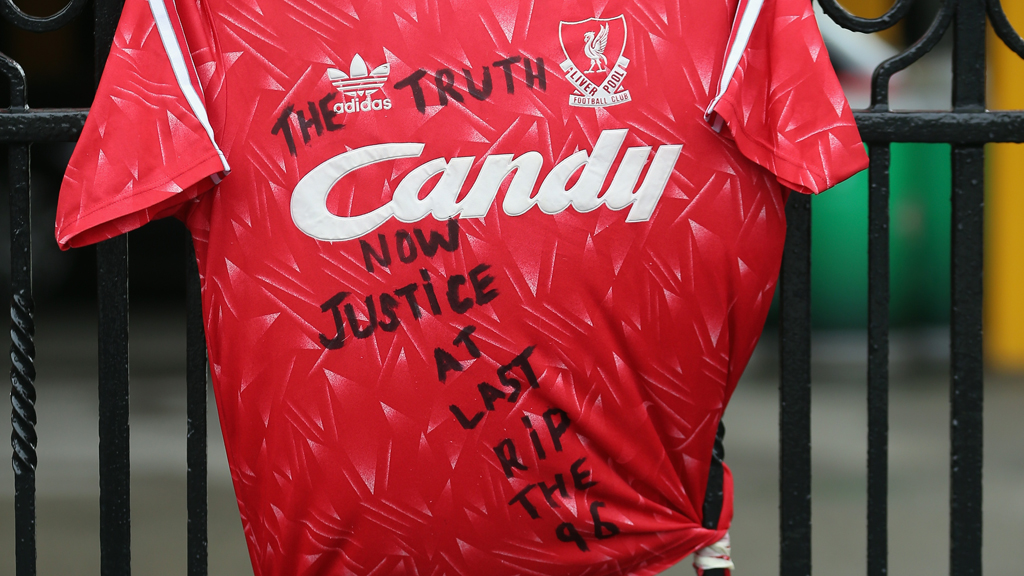Hillsborough report: the key findings
Doctored police statements, lives that could have been saved. Channel 4 News looks at the key findings of the report into the 1989 Hillsborough disaster in which 96 Liverpool fans died.
In the light of the new documents, the panel has highlighted the behaviour of a number of individuals and organisations both during and after the tragedy. It is critical of attempts by some of them to distort or discredit evidence in an attempt to rebuff criticism and blame for the Hillsborough disaster.
The coroner
The documents revealed a number of fresh details which shed light on how the victims died but also showed flaws in the assertion that all of them could not have been saved.
Evidence from pathologists which underpinned a critical decision by the coroner Dr Stefan Popper not to look at evidence of things which happened beyond 3.15pm on that day. This is the point beyond which the coroner decided the victims would have been fatally injured and therefore beyond the help of the emergency services. It was also asserted that the majority of victims died of the same cause – traumatic asphyxiation.
But a review of all of the post-mortems “confirmed that the notion of a single, unvarying and rapid pattern of death in all cases is unsustainable”.
Critically it says: “Some of those who died did so after a significant period of unconsciousness during which they might have been able to be resuscitated”.
“There was clear evidence from the post mortem reports that 28 of those who died did not have traumatic asphyxia with obstruction of the blood circulation, and asphyxia may have taken significantly longer to be fatal. There was separate evidence that in 31 the heart and lungs had continued to function after the crush, and in 16 of these this was for a prolonged period.”
Additionally, the exclusion of evidence from beyond the 3.15 cut-off means that as far as the inquiries into the disaster were concerned, almost all evidence on the response of emergency services after this time would be excluded.
No substantiating evidence
From the outset, alcohol was suggested as one of the reasons the disaster happened and the new evidence shows this theory was reflected in the coroner’s investigations.
He took the “exceptional” step of ordering samples to be taken from all victims to establish blood alcohol levels but this included taking samples from victims as young as 10 years old. A sample was also taken from a 14 year old boy who died in hospital two days after the tragedy.
A document was revealed to the panel which showed “an attempt was made to impugn the reputations of the deceased by carrying out police national computer checks on those with a non-zero alcohol level.”
The panel said: “There was no evidence to support the proposition that alcohol played any part in the genesis of the disaster and it is regrettable that those in positions of responsibility created and promoted a portrayal of drunkenness as contributing to the occurrence of the disaster and the ensuing loss of life without substantiating evidence.”

South Yorkshire emergency services
South Yorkshire police (SYP): Disclosed documents show that police officers, particularly senior officers, interpreted crowd unrest in the Leppings Lane terrace central pens, (where Liverpool fans were standing,) as a sign of potential disorder or hooliganism and failed to see they were in “the throes of disaster”.
The report says when it became clear that Liverpool fans were being crushed, South Yorkshire police ignored their pleas for help or told them to be quiet.
Eye-witness accounts said the tendency of the police to see the disturbance as hooliganism, was a major cause of the “significant delay” in helping out fans before anyone in authority recognised that it was “the throes of a disaster”.
The force did not fully activate its major incident plan, meaning: “Communications between all emergency services were imprecise and inappropriately worded, leading to delay, misunderstanding and a failure to deploy officers to take control and coordinate the emergency response.”
South Yorkshire Metropolitan Ambulance Service (SYMAS): The panel found that the ambulance service also failed to activate its major incident plan, leading to delays, misunderstandings and inappropriately deployed aid. Poor communication between teams inside and outside Hillsborough meant that basic urgent emergency equipment such as swabs was not available where it was needed.
The new documents show “clear and repeated evidence of failures in leadership and emergency response coordination.” The report notes: “While this is understandable in the immediate moments of an overwhelming disaster, it was a situation that persisted for at least 45 minutes after injured spectators were released from the pens.”
The panel rejected the service’s attempts to portray criticism as the views of ill-informed and impulsive doctors caught up in the emotions of the disaster as “factually incorrect”.
The media
Culpability for the disaster appears to have been a motivating factor in moves by South Yorkshire police (SYP) to blame drunken, ticketless fans. Serious allegations were made by newspapers, most infamously The Sun, to discredit Liverpool supporters and back the police’s version of events.
The panel found the allegations came from a local MP and South Yorkshire police.
The claims included stories alleging that Liverpool fans had: “assaulted and urinated on police officers resuscitating the dying, stolen from the dead and verbally sexually abused an unconscious young woman.”
But the new documents and CCTV footage show: “there is no evidence to support these allegations other than a few isolated examples of aggressive or verbally abusive behaviour clearly reflecting frustration and desperation.”
-
Latest news
-
India’s ‘YouTube election’: Influencers enlisted to mobilise youth vote6m

-
Putin denies plans to capture Ukrainian city of Kharkiv3m

-
Plaid Cymru ends co-operation agreement with Welsh Labour government4m

-
Infected blood scandal: Government was warned years before taking action6m

-
Displaced in Gaza have to ‘start from Zero’ many times over, says Gaza NGO director3m

-




